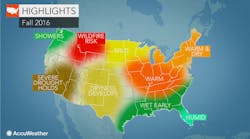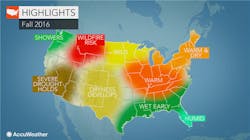This fall, warm weather is predicted across much of the eastern United States, while developing dryness and worsening drought conditions will grip the majority of the western United States, and frequent showers will result in cooler air in the Northwest, AccuWeather recently announced.
Warm, Dry Weather to Dominate Across Northeast, Mid-Atlantic
Building operators anticipating the turn to cool fall weather will have to wait longer than usual this year, as a warm, dry start to the season is in store for the Northeast and mid-Atlantic.
Typical cool shots will hit the region at times in October and November, but prolonged chilly weather will wait until late in the fall for most areas.
"As far as Philadelphia and New York City, I would expect that you're not going to see many arctic shots or cold shots," Paul Pastelok, AccuWeather expert long-range forecaster, said.
"The only days that really may be cool are those that are wet,” Pastelok added. “If the season follows our predictions, we're not expecting too many of those coming up."
Southeast to Remain on Alert for Tropical Impact Into Peak of Atlantic Hurricane Season
Opposite of areas farther north, the Southeast will experience largely beneficial wet weather early.
Northern and southern edges of the region—the Tennessee Valley and South Florida—may be the dry pockets this fall, while rain spreads over the rest of the area.
An active weather pattern in October may allow severe storms to form across Alabama, Georgia, and South Carolina.
"Fronts and any tropical moisture from the Gulf of Mexico—that will all contribute to help out and break this short-term drought that they're in right now," Pastelok said.
Experts predict the 2016 Atlantic hurricane season will yield a normal or slightly above-normal number of storms. However, regardless of season totals, one or two more impacts may be in store for the United States.
Severe Weather to Follow Early Fall Warmth in Midwest
The beginning of fall may seem like an extension of the summer season for much of the Midwest, as heat waves grip the region into September.
"Places like Chicago, St. Louis, and Des Moines, they still have chances to touch 90 degrees or better for a few days in early September," Pastelok said.
Severe storms will intrude on the season for some areas, including St. Louis and Kansas City, Mo.
"Let me stress, though, this is not going to be frequent," Pastelok said. "… I think there will be some breaks in between (storms)."
Cold to Hold Off Until Late Fall for Central United States
Warm and dry conditions will extend over the northern Plains into October, before a quick turnaround to fall-like weather.
Cold shots are predicted to arrive by mid- to late November. The cold air, paired with a likely transition to a La Niña weather pattern, could allow snow to fall in late November.
"The more snow we see, the colder the end of November and into early December will be," Pastelok said.
In the southern Plains, a large area of developing dryness will promote hot weather into the fall. The exception may be eastern Texas, where tropical moisture will help to lower temperatures.
Despite the temperature divide across the region, severe weather is unlikely to pose a major risk into fall.
Cool, Showery Weather in Store for Northwest
Cool, showery weather will define the fall across the Northwest.
Periods of wet weather—some lasting a few weeks—will allow cooler air to become entrenched across the region.
Snow could build up in the highest elevations of the Northwest as soon as late September or early October this year, slightly faster than normal.
Lack of Rain to Amplify Drought in West
After El Niño failed to bring sufficient rain and snow to California and the West last winter, drought conditions will continue to raise the risk of devastating wildfires.
Heading into the peak of the wildfire season, which stretches into September, a lack of moisture will allow dry vegetation to serve as fuel for new and ongoing blazes.
"It's bad now, and it's only going to get worse," Pastelok said.
Additionally, Santa Ana winds will fan the flames of existing fires, helping them to spread.
Dryness also will continue in the Southwest, despite some early rainfall from the monsoon.
"We still may have another spurt of moisture here and there into early September in eastern parts of Utah, but, other than that, those areas will start to dry out as well by middle fall," Pastelok said.










